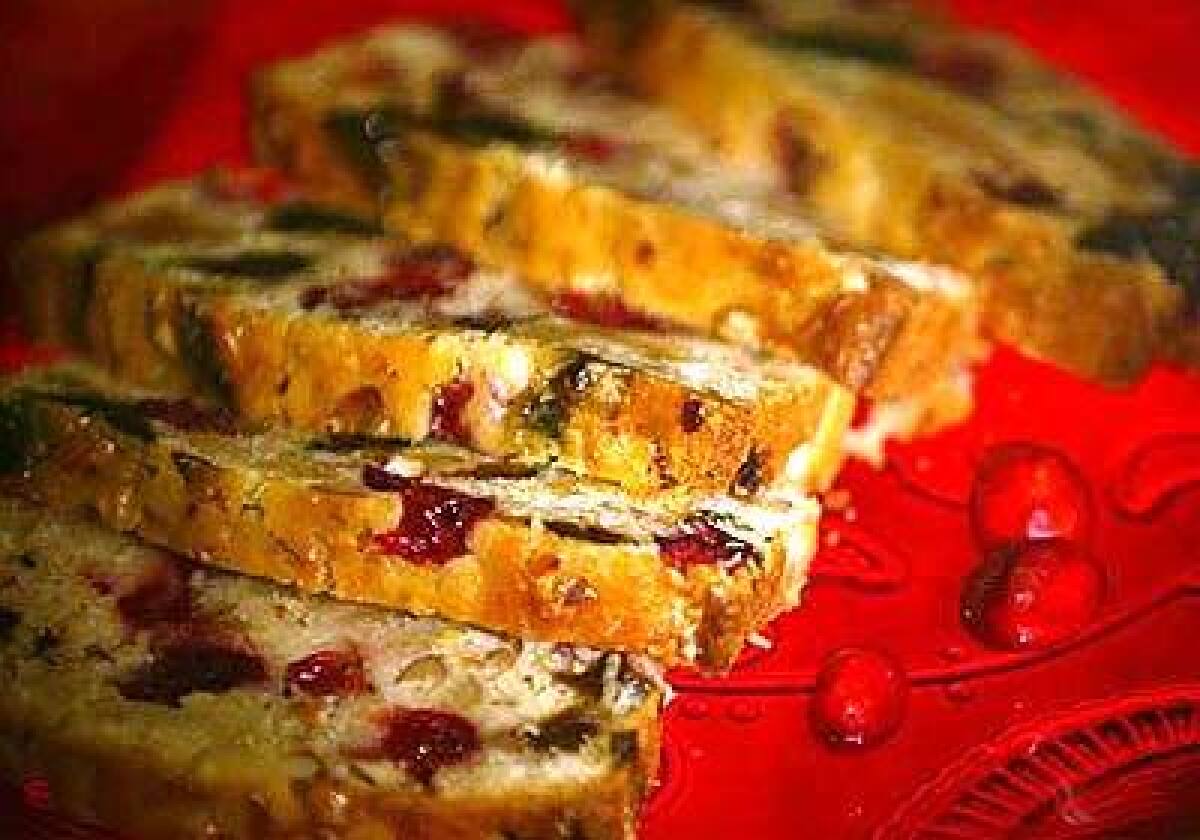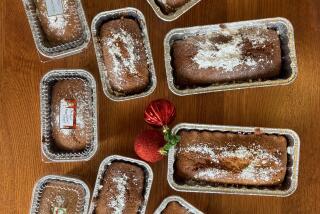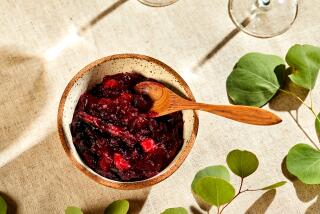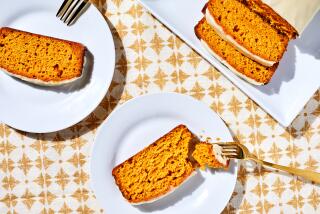The cranberry factor

The sign in the produce section was a shocker. How could it be? “Sorry. Out of cranberries.” I leaned on my cart, incredulous, caught unaware by the cranberry shortage.
It was the day before Thanksgiving. I don’t remember the year — sometime in the early ‘90s. I was on my last swing through the grocery store. Although each of the guests at my 24-person dinner would bring a dish, there were dozens of little things my husband and I still needed, from pickles to cranberries.
We needed lots of cranberries. With so many people, we always served at least three kinds of sauce or relish. Not to mention the cranberries I’d need for dessert — cranberry-apple pie. In a cranberry panic, I ran from store to store trying to find enough for our feast. Some stores were out, others had imposed a limit: “one per customer.”
Somehow we made it. But every autumn since, as soon as the first cranberries appear in the grocery stores, I grab three bags. If I’m not ready to use them, I toss them in the freezer.
My hoarding tendencies reemerge annually not just because cranberries are traditional (we could do without candied yams, for example, if there should be a sudden yam blight) but because I’m crazy about them.
Cranberries taste like they look. Tart and tangy, they don’t taste blue or purple, and they’re not at all pink on the palate like a tropical fruit. Their flavor, like their color, is saturated, intense.
And that beyond-citrus intensity is essential this time of year. The rich, creamy foods that rule our tables cry out for touches of spice and piquancy.
As a sweet but assertive, fruity complement to savory dishes, especially those with early American roots — game birds and poultry, wild rice, corn bread, sausage, apples — cranberries can’t be beat.
Fresh cranberry relish is most often made with orange zest, and while that pairing is appealing, lemon is even better, more unexpected and almost startling.
A batch of cranberry-lemon relish with dried fig takes almost no time to make and greets your mouth with a wow-I’m-alive! tartness and crunch, then goes a step further and gives you a sweet, figgy finish.
Dried cranberries are as easy to find as raisins these days. Bakers use them as raisin substitutes in scones and muffins, but fresh cranberries are a much more exciting addition.
Although they blend in deliciously when sweetened, they never lose their tartness, and if used generously, they bring sophistication to even the homiest comfort-food recipes.
Take cranberry upside-down cake. It’s easy to put together for a family dinner, and served warm from the oven, the cake layer is rich, buttery and nutmeg-scented. The topping of brown sugar-sweetened cranberries, though, is what gives it zing.
The fruits formerly known as prunes (now grandly renamed dried plums) are rarely combined with cranberries, but when they are, in a fruitcake with almonds, the effect is delightful.
The loaf is dense with fruit and nuts, which will please fruitcake traditionalists, but the cranberries make it so sprightly that it also appeals to folks who shy away from the sticky-sweet stuff. Orange syrup instead of brandy as a soaking liquid makes for a light but moist and flavorful cake.
This loaf can be made using frozen cranberries. You don’t need to thaw them; just rinse and toss them in with the other ingredients. It’s a great recipe for the weeks between Thanksgiving and Christmas, when nervous cranberry lovers like me can finally be profligate with our stashes.
*
Cranberry-lemon relish
Total time: 10 minutes, plus at least 1 hour chilling
Servings: Makes 3 cups
Note: From Donna Deane
1 (12-ounce) bag cranberries
Zest of one lemon, minced
1 cup sugar
1/2 cup chopped dried Mission figs
1. Wash the cranberries in a colander under cold running water. Remove any bruised or soft berries. Pat the cranberries dry on paper towels.
2. Add the cranberries and the lemon zest to a food processor and pulse until the berries are finely chopped.
3. Spoon the mixture into a glass bowl. Add the sugar and the figs and stir to blend. Cover and chill in the refrigerator for at least 1 hour. Best if chilled overnight.
Each serving: 25 calories; 0 protein; 6 grams carbohydrates; 1 gram fiber; 0 fat; 0 saturated fat; 0 cholesterol; 0 sodium.
*Cranberry-prune loaf
Total time: 1 hour, 30 minutes
Servings: About 24 (makes 2 loaves)
Note: To use frozen cranberries, rinse, drain and add to other ingredients while frozen.
Orange syrup
1 cup orange juice
1 cup sugar
1. Combine the orange juice and sugar in a small saucepan over low heat. Bring to a simmer to dissolve the sugar. Cool slightly.
Cakes
2 1/2 cups flour
1 cup sugar
1 teaspoon baking powder
1/4 teaspoon salt
1 1/2 cups coarsely chopped pitted prunes
1 1/2 cups fresh or frozen whole cranberries
1 cup coarsely chopped dried pears
2 cups coarsely chopped toasted almonds
2 eggs
1 cup buttermilk
3/4 cup vegetable oil
1 1/2 tablespoons grated orange peel
Orange syrup
1. Heat the oven to 350 degrees. Grease and flour two 9-by-5-inch loaf pans. Combine the flour, sugar, baking powder and salt in a large bowl.
2. Add the prunes, cranberries, dried pears and almonds and stir to coat the fruit.
3. In a medium bowl, beat the eggs, then stir in the buttermilk, oil and orange peel.
4. Add the egg mixture to the flour mixture and stir with a wooden spoon just until thoroughly blended.
5. Divide the batter between the two loaf pans. Smooth the tops with a rubber spatula. Bake until a toothpick inserted into center comes out clean, about 1 hour, 5 minutes.
6. While the cakes are still hot, prick them with a skewer all over the tops and spoon one-fourth cup warm orange syrup over each cake. Allow the cakes to cool for 10 minutes, then invert them onto a rack over a baking sheet. Prick the bottom surfaces and slowly spoon the remaining (warmed) syrup over the loaves.
7. Cool to room temperature. Wrap in aluminum foil and allow to stand at room temperature for 24 hours before serving. Refrigerate for longer storage.
Each serving: 284 calories; 4 grams protein; 43 grams carbohydrates; 3 grams fiber; 12 grams fat; 1 gram saturated fat; 18 mg. cholesterol; 58 mg. sodium.
*Cranberry upside-down cake
Total time: 1 hour
Servings: 9
Note: From Donna Deane
Topping
1/3 cup butter
1 cup sugar
2 tablespoons water
1 package (12 ounces) cranberries
1/2 teaspoon vanilla
1. Heat the butter in a small saucepan until melted. Add the sugar and water and cook, stirring until the sugar is dissolved. Add the cranberries and vanilla and stir to combine.
2. Pour the mixture into a buttered 8-inch square baking dish. Set it aside while preparing the cake batter.
Cake
1/2 cup butter
1 cup packed brown sugar
2 eggs
3/4 cup sour cream
1 teaspoon vanilla
1 teaspoon grated orange peel
1 1/2 cups cake flour
1/2 teaspoon baking soda
1/4 teaspoon grated nutmeg
1/2 teaspoon salt
1. Heat the oven to 350 degrees. Using an electric mixer, beat the butter until light. Add the brown sugar and beat until blended. Beat in the eggs, one at a time. Add the sour cream, vanilla and orange peel and mix.
2. In a small bowl, stir together the flour, baking soda, nutmeg and salt.
3. Add the dry ingredients to the butter-sugar mixture and beat until the ingredients are blended and the batter is light, about 2 to 3 minutes.
4. Spoon the batter evenly over the cranberry mixture in the baking pan and use the back of the spoon or a spatula to spread it smooth.
5. Bake until the cake tests done in the center, about 40 to 45 minutes. Remove the cake from the oven and let it stand 5 minutes, then invert it onto a serving platter. Cool slightly before cutting and serving warm.
Each serving: 490 calories; 4 grams protein; 70 grams carbohydrates; 2 grams fiber; 22 grams fat; 13 grams saturated fat; 101 mg. cholesterol; 236 mg. sodium.
More to Read
Eat your way across L.A.
Get our weekly Tasting Notes newsletter for reviews, news and more.
You may occasionally receive promotional content from the Los Angeles Times.










